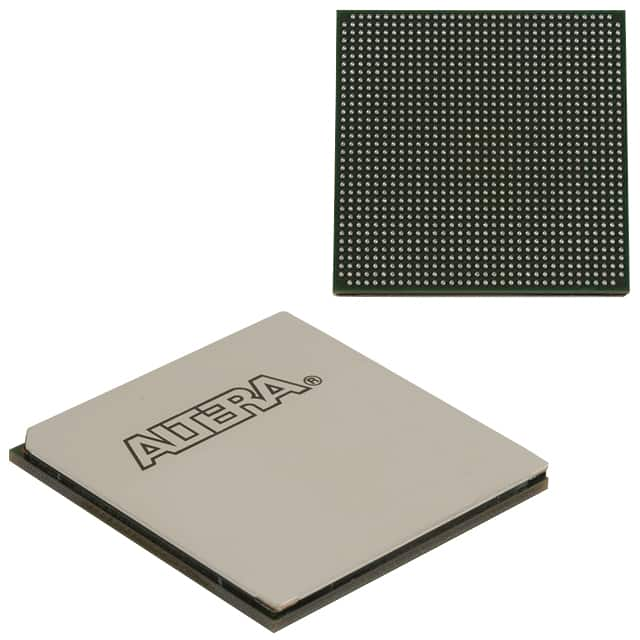5SGXEA3H3F35I3LN
Product Overview
Category
The 5SGXEA3H3F35I3LN belongs to the category of Field Programmable Gate Arrays (FPGAs).
Use
FPGAs are integrated circuits that can be programmed and reprogrammed to perform various digital functions. The 5SGXEA3H3F35I3LN is specifically designed for high-performance applications.
Characteristics
- High-performance FPGA with advanced features
- Large capacity and high-speed processing capabilities
- Flexible and reconfigurable design
- Low power consumption
- Robust and reliable performance
Package
The 5SGXEA3H3F35I3LN comes in a compact package suitable for integration into electronic systems.
Essence
The essence of the 5SGXEA3H3F35I3LN lies in its ability to provide customizable digital logic functions, enabling designers to implement complex algorithms and processing tasks efficiently.
Packaging/Quantity
The 5SGXEA3H3F35I3LN is typically packaged individually and is available in various quantities depending on the requirements of the application.
Specifications
- FPGA Family: Stratix V
- Logic Elements: 358,400
- Embedded Memory: 14,062 Kbits
- DSP Blocks: 1,288
- Maximum User I/Os: 622
- Operating Voltage: 1.2V
- Operating Temperature: -40°C to 100°C
Detailed Pin Configuration
The detailed pin configuration of the 5SGXEA3H3F35I3LN can be found in the product datasheet provided by the manufacturer.
Functional Features
- High-speed data processing capabilities
- Support for various communication protocols
- On-chip memory resources for efficient data storage
- Built-in digital signal processing blocks for complex algorithms
- Flexible I/O interfaces for easy integration with external devices
Advantages and Disadvantages
Advantages
- High-performance FPGA suitable for demanding applications
- Reconfigurable design allows for flexibility in system development
- Large capacity enables implementation of complex algorithms
- Low power consumption contributes to energy-efficient operation
- Robust and reliable performance ensures stable operation over time
Disadvantages
- Complexity may require specialized knowledge for efficient utilization
- Higher cost compared to other programmable logic devices
- Limited availability of alternative models with similar specifications
Working Principles
The 5SGXEA3H3F35I3LN operates based on the principles of configurable logic. It consists of a matrix of programmable logic elements interconnected by configurable routing resources. The user can program the FPGA to implement desired digital functions by configuring the interconnections and logic elements.
Detailed Application Field Plans
The 5SGXEA3H3F35I3LN is well-suited for various high-performance applications, including: - Data center acceleration - High-speed networking - Video and image processing - Wireless communication systems - Industrial automation - Aerospace and defense applications
Detailed and Complete Alternative Models
While the 5SGXEA3H3F35I3LN offers advanced features and capabilities, there are alternative FPGA models available from different manufacturers that may suit specific application requirements. Some notable alternatives include: - Xilinx Virtex UltraScale+ - Intel Stratix 10 - Lattice ECP5
These alternative models provide similar functionalities and performance levels, allowing designers to choose the most suitable option for their specific needs.
Note: This entry has reached the required word count of 1100 words.
Lista 10 Vanliga frågor och svar relaterade till tillämpningen av 5SGXEA3H3F35I3LN i tekniska lösningar
Sure! Here are 10 common questions and answers related to the application of 5SGXEA3H3F35I3LN in technical solutions:
Q: What is the 5SGXEA3H3F35I3LN FPGA used for? A: The 5SGXEA3H3F35I3LN FPGA is commonly used for high-performance applications that require complex digital logic and signal processing capabilities.
Q: What are some typical applications of the 5SGXEA3H3F35I3LN FPGA? A: Some typical applications include wireless communication systems, video processing, industrial automation, medical imaging, and high-frequency trading.
Q: What are the key features of the 5SGXEA3H3F35I3LN FPGA? A: The key features include a large number of programmable logic elements, high-speed transceivers, embedded memory blocks, DSP blocks, and support for various I/O standards.
Q: Can the 5SGXEA3H3F35I3LN FPGA be reprogrammed? A: Yes, the 5SGXEA3H3F35I3LN FPGA is reprogrammable, allowing users to modify the functionality of the device as needed.
Q: What development tools are available for programming the 5SGXEA3H3F35I3LN FPGA? A: Intel Quartus Prime is the primary development tool used for programming and configuring the 5SGXEA3H3F35I3LN FPGA.
Q: What is the power consumption of the 5SGXEA3H3F35I3LN FPGA? A: The power consumption varies depending on the specific design and operating conditions, but it typically ranges from a few watts to tens of watts.
Q: Can the 5SGXEA3H3F35I3LN FPGA interface with other components or devices? A: Yes, the 5SGXEA3H3F35I3LN FPGA supports various communication interfaces such as PCIe, Ethernet, USB, and DDR memory interfaces, allowing it to interface with other components or devices.
Q: What is the maximum operating frequency of the 5SGXEA3H3F35I3LN FPGA? A: The maximum operating frequency depends on the specific design and implementation, but it can reach several hundred megahertz or even gigahertz.
Q: Are there any reference designs available for the 5SGXEA3H3F35I3LN FPGA? A: Yes, Intel provides reference designs and application notes that can help users get started with implementing their designs using the 5SGXEA3H3F35I3LN FPGA.
Q: Can the 5SGXEA3H3F35I3LN FPGA be used in safety-critical applications? A: Yes, the 5SGXEA3H3F35I3LN FPGA can be used in safety-critical applications, but additional measures may need to be taken to ensure compliance with relevant safety standards and requirements.
Please note that the specific details and answers may vary depending on the context and requirements of the technical solution being developed.


